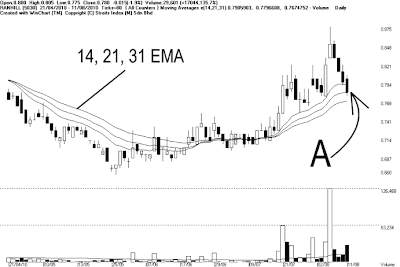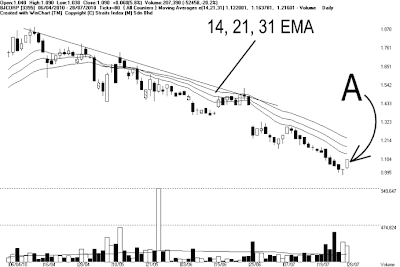Airasia – 5099: 32 months new high.
Chart 1: Airasia – 5099 (28/04/2010~18/08/2010)
As shown on chart 1, price of Airasia rebounded from the 14, 21 ,31 EMA (Exponential Moving Average – EMA ) on the 13th of August, and later resumed its uptrend, breaking above the RM1.70 level, making a 32 months new high.
However, after breaking above the RM1.70 level, price of Airasia failed to continued its rally, and started to move sideways. But still, based on the analysis of chart 1, the uptrend of Airasia is still intact, with the 14, 21, 31 EMA still serving as the dynamic support. Therefore, it is a good idea to hold on the the position as long as the price of Airasia is above the 14, 21, 31 EMA, until price should break below the 14, 21, 31 EMA, it would be a signal to cut loss or to take profit.
As for investors whom are interested in taking up position, the ideal entry point would be a higher-low, above the 14, 21, 31 EMA with strong volume, and immediately after buying, he or she should apply the 14, 21, 31 EMA as a trailing stop reference. Nonetheless, resistance for Airasia is at RM1.72~RM1.75 level.
| 4 Q Rolling PER | 6.8 times | Dividend Y ield | 0% |
| Dividend | Dividend Yield | Net Profit Ratio | |
| 31/12/2009 | 0 sen | 0 % | 17.27 % |
| 31/12/2008 | 0 sen | 0 % | -17.87% |
| 31/12/2007 | 0 sen | 0 % | 38.90 % |
| 31/12/2006 | 0 sen | 0 % | 31.07 % |
| 31/12/2005 | 0 sen | 0 % | 10.25 % |
Table 1: Airasia – 5099, yearly dividend, dividend yield, and net profit ratio.
XDL – 5156: Correction during an uptrend.
Chart 2: XDL – 5156 (28/04/2010~ 18/08/2010)
As shown on chart 2, price of XDL formed an uptrend, marked T1, while continue being supported by the 14, 21, 31 EMA. Thus the 14, 21, 31 EMA is also serving as the dynamic support for XDL.
Despite price of XDL retreated after hitting a resistance at RM0.515, the uptrend remains unaffected, as long as price of XDL could remain above the 14, 21, 31 EMA or the T1 uptrend line. In fact, if price should rebound from the 14, 21, 31 EMA or the T1 line and form a higher-low, with volume, it would be another buy signal, for the uptrend is likely to continue. But immediately after buying, investors should apply the 14, 21, 31 EMA as the trailing stop reference.
However, on the other hand, if price should break below the 14, 21, 31 EMA or the T1 line after this technical correction, it means that the uptrend is violated, and therefore, is is a signal to take profit or the cut loss. This is to avoid being caught by the falling of price. Resistance for XDL is at RM0.515 while the support is at RM0.42.
| Leading PER | 2.69 times | Dividend Yield | 0.00% |
| Dividend | Dividend Yield | Net Profit Ratio | |
| 31/12/2009 | 0 sen | 0% | 17.77 % |
Table 2: XDL – 5156, yearly dividend, dividend yield, and net profit ratio.
Supermx – 7106: Breaking below long term uptrend.
Chart 3: Supermx – 7106 (28/04/2010~18/08/2010)
As shown on chart 3, price of Supermx was staying above the T1 line for quite a long time, gaining about RM5.80 or 860%. As indicated by A, price of Supermx broke below the T1 uptrend line, suggesting that the T1 uptrend is no-long valid. Meanwhile, price of Supermx also broke below the 14, 21, 31 EMA, thus the 14, 21, 31 EMA is now serving as the dynamic resistance, and the immediate technical outlook for Supermx is on the negative side.
Technically, as long as the price of Supermx is below the 14, 21, 31 EMA, the outlook shall expected to be bearish biased, despite the price is getting lower. It is important to know the high risk of trying to catch the bottom, or buying too early.
Investors are urge to identify the characteristic of an uptrend, which is higher-low and new high. But if price should stay in a downtrend, its characteristic would be a lower-high and new low. Therefore, a disciplined investors would only buy with the uptrend characteristic, not because of the relatively lower price. Nevertheless, support for Supermx is at RM5.22 while the resistance is at the 14, 21, 31 EMA dynamic resistance as well as the RM6.00 level.
| 4 Q Rolling PER | 9.14 times | Dividend Yield | 2% |
| Dividend | Dividend Yield | Net Profit Ratio | |
| 31/12/2009 | 11 sen | 2.01 % | 15.29% |
| 31/12/2008 | 3.25 sen | 4.06 % | 5.58% |
| 31/12/2007 | 1.9 sen | 0.63 % | 13.85% |
| 31/12/2006 | 6.5 sen | 1.56 % | 10.49% |
| 31/12/2005 | 6.5 sen | 1.46 % | 12.74% |
Table 3: Supermx – 7106, yearly dividend, dividend yield, and net profit ratio.
Conclusion:
Even though the broad market is trending up, investors would still have to honor their trading plan for individual counters. When price breaks below an uptrend, a logic thing to do is to take profit or to cut loss, to avoid being caught by the downtrend. Remember, never try to catch the bottom thinking that it is the lowest price.
Copyright © 2009 Straits Index (M) Sdn BhdImportant Disclaimer:These content provided by Straits Index (M) Sdn Bhd is solely for education and information purposes only, and do not suggest any investment advices. All information displayed are believed to be accurate and reliable. Interpretation of the data or analysis is at the reader's own risk. Straits Index (M) Sdn Bhd reserves the rights but obligations to update, admen, or even terminate the materials. 重要声明:以上的内容由海峡指数(马)私人有限公司提供,纯粹是教育性质, 并不是任何的投资忠告。所有资料显示认为是准确和可靠的。对数据或分析的解释和用途是在于用户自己的风险。海峡指数(马)有限公司持有保留及义务更新,甚 至终止材料的权利。


























